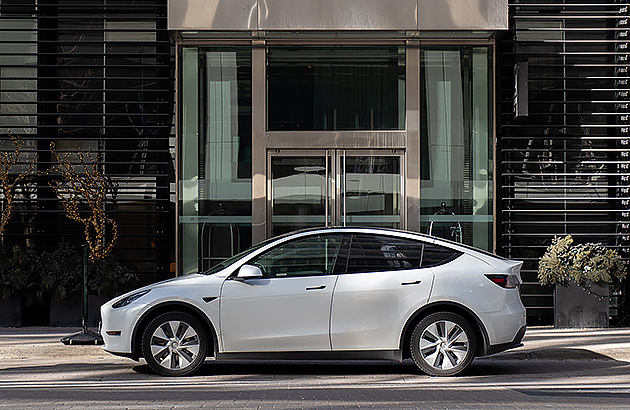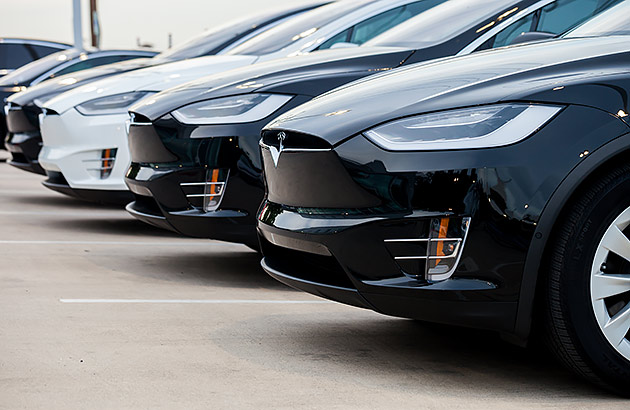Last updated: 7 March 2025 By: Toby Hagon
Electric cars have been cheaper for many Australians courtesy of a tax exemption announced in 2022.
The Fringe Benefits Tax (FBT) exemption allows salaried employees to take out a novated lease on an electric vehicle (EV) and pay for it wholly from their pre-tax income but not pay the fringe benefits tax that would normally be incurred.
The FBT exemption has also applied to plug-in hybrid electric vehicles, although for those vehicles – which typically drive between 40km and 100km on electricity before reverting to a petrol engine - it expires on March 31, 2025.
For all other EVs, the FBT exemption on battery electric vehicles is due to continue until at least mid-2027.
In announcing the FBT exemption Treasurer Jim Chalmers said it could save employees up to $4700 a year on a $50,000 vehicle and employers up to $9000 annually.
Some have described the fringe benefits tax exemption on electric cars as a game changer for the industry, such is its ability to offset the price premium attached to most EVs.
But for those wanting to purchase an EV for private use, the FBT exemption only applies to those taking out a novated lease.
People paying cash for a car or taking out a separate loan – including borrowing against their home loan – will not get any benefit.
RELATED:
Electric cars Available in Australia »

What is a novated lease?
A novated lease is a way of financing a vehicle that uses salary sacrificing with the aim of providing tax benefits to the person taking out the loan.
It allows you to pay for the financing of a car and its running costs from your pre-tax salary. The financing is arranged with an external leasing company through your employer. But the lease belongs to you, so if you leave your employer, it’s up to you to transfer the lease, refinance or continue repayments.
A novated lease requires the employer to be open to facilitating the financing through its payroll system but given there is no financial penalty to the company it is a matter of paperwork.
There can also be minor benefits in payroll tax to the employer given the amount of money being paid to the employee will be less once the leasing payments are deducted.
What is the Fringe Benefits Tax?
The FBT is a tax paid by employers on certain benefits provided to their employees.
If a car is provided by your company not as a tool of trade vehicle but as one chosen by you for your personal use, it will typically attract fringe benefits tax.
That’s the Australian Taxation Office’s way of taking a cut because the vehicle is treated as a different form of payment.
FBT is paid by your employer, but most novated leases are structured with after-tax contribution payments that eliminate the requirement for the company to pay FBT.
Having to pay for some of the lease from after-tax earnings means less in an employee’s take-home pay.
With the FBT exemption on EVs, there is no need for that after-tax payment, allowing employees to fund the purchase and running costs of the vehicle wholly from their pre-tax salary.
“Prior to the [FBT] exemption some of the costs associated with a lease were coming out pre-tax and some of it was coming out after tax to offset fringe benefits tax liability,” explains Steven Ogle, the group product manager, employee benefits for SG Fleet, Australia’s largest vehicle leasing and fleet management company.
"With this exemption, all of the payments are from pre-tax income, so the income tax savings are a lot better.”
Are all electric cars eligible for the FBT exemption?
While the FBT exemption is applicable across new and used electric vehicles, it can only be utilised on cars sold on or after 1 July 2022.
Electric vehicles include battery electric vehicles (the things people generally refer to as EVs) or a fuel cell EV (which converts hydrogen into electricity).
There are now more than 100 battery electric vehicles available in Australia, many of them eligible for the FBT exemption.
However, the FBT exemption also only applies to cars that have never paid any luxury car tax (LCT).
The LCT is a tax on vehicles that have a total value above a certain threshold. Fuel efficient vehicles are those that use 7L/100km or less. The tax is paid by car dealerships or anyone who imports a luxury car. The LCT threshold is typically increased annually.

In the 2022/2023 financial year, the LCT threshold for EVs was $84,916, inclusive of GST, dealer delivery and accessories but exclusive of government charges such as registration and stamp duty. In financial year 2024-2025 the LCT threshold on fuel efficient vehicles was $91,387.
When choosing your car, be mindful of add-ons. The price of the vehicle may be below the threshold, but if add any optional extras, you risk busting the threshold and missing out on the tax advantage.
Fortunately, most dealers are well aware of the tax advantages and can help in choosing a model that adheres to the ATO criteria.
RELATED:
How To Charge An Electric Car At Home »
How much could you save?
The higher the tax rate, the bigger the savings.
Because of the structure of a novated lease – whereby payments are made from your pre-tax income – the benefits are usually greater for those paying a higher tax rate.
Anyone earning over $190,000, for example, is paying 45 cents per dollar earned whereas those earning $45,001-$135,000 pay 30 cents.
If you’re funding your car from your pre-tax income, anyone on the top tax rate will effectively be saving 45 cents in the dollar, whereas those earning an average wage will only save 30 cents per dollar.
RELATED:
Electric car incentives around Australia »
We used SG Fleet’s online calculator to crunch the numbers on some popular new cars, three of them EVs and one a plug-in hybrid in the form of the BYD Shark 6 ute.
The four vehicles we chose were all eligible for the FBT exemption, whereas the petrol models were not.
We also got quotes for three different salary ranges from $100,000 up to $200,000.
We assumed a four-year lease term covering 15,000km annually. The figures include registration, insurance, servicing and tyre replacement costs. For the fossil fuel-powered vehicles it also includes fuel costs, but it doesn’t include charging costs for an EV. That’s in part because there’s no current tax office ruling on getting reimbursed from electricity at home (for those charging from the grid, though, an average EV would cost about $700 a year).
The figures also don’t include the one-off payment at the end of the lease term. The ATO currently calculates that at 37.5 per cent of the purchase price plus GST and registration for the fifth year; it works out to a little less than half the original purchase price.
While residual values of EVs have been weak over the past couple of years, there’s still a strong chance you’ll have a vehicle worth more than the final payment.
EV to ICE leasing comparison - Annual income $100,000
| EV/PHEV | Purchase price | Pre-tax payment | Post-tax payment | Take home pay impact |
|---|---|---|---|---|
| MG4 Excite 5 | $34,536 | $13,418.63 | $0.00 | $9174.63 |
| Tesla Model 3 RWD | $49,909 | $19,036.62 | $0.00 | $12,944.62 |
| Toyota bZ4X | $60,000 | $20,897.41 | $0.00 | $14,210.41 |
| BYD Shark 6 (pre-March 31) | $52,636 | $20,939.55 | $0.00 | $14,239 |
| BYD Shark 6 (post-April 1) | $52,636 | $9359.55 | $11,580 | $17,944.55 |
| Petrol/diesel | Purchase price | Pre-tax payment | Post-tax payment | take home pay impact |
|---|---|---|---|---|
| Mazda3 GT | $36,464 | $9533.63 | $8152.90 | $14,635.53 |
| Toyota Camry Ascent Sport | $39,082 | $9010.47 | $8713.50 | $14,840.97 |
| Toyota RAV4 Cruiser FWD | $46,736 | $9312.30 | $10,397.50 | $16,729.80 |
| Ford Ranger Wildtrak V6 | $68,036 | $12,877.01 | $15,166.70 | $23,922.71 |
EV to ICE leasing comparison - Annual income $150,000
| EVs | Purchase price | Pre-tax payment | Post-tax payment | Take home pay impact |
|---|---|---|---|---|
| MG4 Excite 51 | $34,536 | $13,418.63 | $0.00 | $8185.63 |
| Tesla Model 3 RWD | $49,909 | $19,036.62 | $0.00 | $11,894.62 |
| Toyota bZ4X | $60,000 | $20,897.41 | $0.00 | $13,160.41 |
| BYD Shark 6 (pre-March 31) | $52,636 | $20,939.55 | $0.00 | $13,189 |
| BYD Shark 6 (post-April 1) | $52,636 | $9359.55 | $11,580 | $17,289.55 |
| Petrol/diesel | Purchase price | Pre-tax payment | Post-tax payment | take home pay impact |
|---|---|---|---|---|
| Mazda3 GT | $36,464 | $9533.63 | $8152.90 | $13,968.53 |
| Toyota Camry Ascent Sport | $39,082 | $9010.47 | $8713.50 | $14,209.97 |
| Toyota RAV4 Cruiser FWD | $46,736 | $9312.30 | $10,397.50 | $16,077.80 |
| Ford Ranger Wildtrak V6 | $68,036 | $12,877.01 | $15,166.70 | $23,021.71 |
EV to ICE leasing comparison - Annual income $200,000
| EVs | Purchase price | Pre-tax payment | Post-tax payment | Take home pay impact |
|---|---|---|---|---|
| MG4 Excite 51 | $34,536 | $13,418.63 | $0.00 | $7385.63 |
| Tesla Model 3 RWD | $49,909 | $19,036.62 | $0.00 | $10,812.62 |
| Toyota bZ4X | $60,000 | $20,897.41 | $0.00 | $11,947.41 |
| BYD Shark 6 (pre-March 31) | $52,636 | $20,939.55 | $0.00 | $11,973 |
| BYD Shark 6 (post-April 1) | $52,636 | $9359.55 | $11,580 | $16,540.55 |
| Petrol/diesel | Purchase price | Pre-tax payment | Post-tax payment | take home pay impact |
|---|---|---|---|---|
| Mazda3 GT | $36,464 | $9533.63 | $8152.90 | $13,205.53 |
| Toyota Camry Ascent Sport | $39,082 | $9010.47 | $8713.50 | $13,234.69 |
| Toyota RAV4 Cruiser FWD | $46,736 | $9312.30 | $10,397.50 | $15,322.80 |
| Ford Ranger Wildtrak V6 | $68,036 | $12,877.01 | $15,166.70 | $22,221.71 |
Table notes: Figures provided by SG Fleet’s online calculator. FBT exempt figures for the BYD Shark 6 were calculated by adding the pre- and post-tax contributions to get an annual running cost that could be wholly included in the pre-tax income calculations. Vehicle prices typically include estimated fleet discounts and exclude GST. Leasing terms are 48 months assuming 15,000km annually for a car registered in the Perth CBD. Running costs include registration, insurance, fuel/electricity, servicing, roadside assistance, tyres. The ATO stipulates the minimum residual payment at the end of the four-year lease is 37.5 per cent of the original purchase price.
The numbers are certainly favourable for EVs. For someone earning $100,000 an MG4 Excite 51 would mean $9174.63 less in the bank account each year, versus $13,968.53 for a Mazda3 GT.
The difference is more dramatic the more you earn.
Someone shopping for a Toyota RAV4 would want to consider the considerably more expensive bZ4X alongside it in the showroom. If you’re earning $200,000 a RAV4 Cruiser would cost $15,322.80 annually whereas the bZ4X only drains $11,947.41.
And the numbers highlight the appeal of leveraging the FBT exemption for the BYD Shark 6, the first plug-in hybrid ute on sale.
Sign a lease on one before April 1 and it’ll cost between and $11,973 and $14,239.
Leave it until April 1 and estimates suggest that will jump to between $16,540.55 and $17,944.55.
For someone earning $200,000 that amounts to a saving of $4567.55 per year, or $18,270.20 over the four-year term of the lease.

Novated lease versus personal loan
Of course, there are other options for financing a vehicle, including cash, taking out a personal loan or borrowing against your house.
The latter, in particular, could yield a lower interest rate than you’d get through a leasing company, although keep in mind that a novated lease typically locks the financing rate at the point of sign-up, rather than jumping around with the cash rate set by the Reserve Bank.
With interest rates expected to drop over coming years it’s something worth considering.
And, of course, independent finance costs generally can’t be packaged in a tax effective way.
RELATED:
Buying A Second-Hand Electric Car »
Take the example of a circa-$60,000 car. If you were financing it through a traditional lender, you’d be up for about $3900 in annual interest repayments if you had a loan at 6.5 per cent (which could change during the loan term). There’s also upwards of a few thousand in registration, insurance and servicing.
So it would be something like $7,000 per year – or closer to $9,000 if you’re financing at 8 per cent interest.
Think something close to $36,000 over four years - and that's before you go paying the loan principal.
With an FBT-exempt novated least the total annual cost would range from about $11,000 to $13,000 – something around $45,000 after four years - and you will have paid off more than half the vehicle at the end of the term.

What happens if I change employers?
You’ll need to contact the lease provider and let them know you’ll be leaving your current employer and will be managing the lease yourself in the interim.
If you’re switching to a new employer, they may be able to take over managing the lease. Your lease provider will manage that process with your new employer.
If your new employer won’t manage the lease for you, you’ll need to keep making payments directly to the lease provider, but of course, these payments won’t be from your pre-tax salary.
You can also sell the vehicle to pay out the remainder of what you owe, provided the car is worth more than or is at least equal to the amount left to pay off.
It’s worth considering Lease Protection Insurance as part of the arrangement with your lease provider. It will cover you if you’re unable to make repayments for a number of covered circumstances, including involuntary redundancy.
Check for the circumstances that are covered under the policy, the time period they’ll cover you for and what exclusions apply.
Once you come to the end of a lease, having paid out the full amount, there will be a one-off payment, with the size of that payment dependent on the original purchase price and the term of the lease.
Beware of other tax implications
The FBT exemption may be a great way to save money, but those signing up need to be aware of other implications.
While you won’t pay FBT on applicable vehicles, the FBT benefit still needs to be reported.
Depending on your income and reportable fringe benefits it can be used to determine your eligibility and entitlement for things such as the private health insurance rebate, parental leave, child care subsidies and child support obligations, among others.
It can also be used to calculate things such as repayments for HECS or student loans and to establish whether you need to pay the Medicare levy. That’s why it’s important to discuss your circumstances with an accountant or tax advisor, because some or all of those savings may be lost elsewhere.
“Everyone's individual circumstance is different,” says Ogle. “There are great up-front tax savings but you still need to assess any flow-on effects.”
He says it’s crucial people go beyond the headline savings and “look at the holistic impact on your household, not just this year, but next year and the year after”.
If all the stars align, then taking a novated lease on an EV can make plenty of sense.
Considering an EV? Get a discount on your car loan interest rate.
Get 0.50% p.a. off your car loan interest rate when you buy an electric vehicle.
T&Cs: Discount applies to fully electric new and used vehicles, excludes Hybrid vehicles. Offer is subject to RAC Finance Lending Terms and Conditions. Fees and charges apply. Australian Credit Licence 387972.
